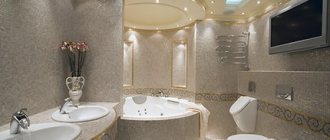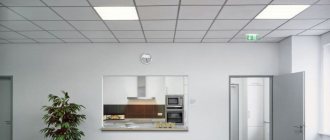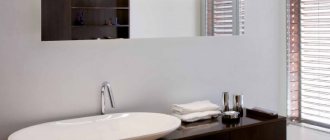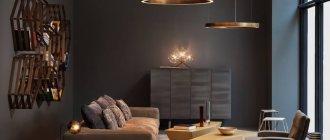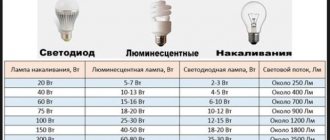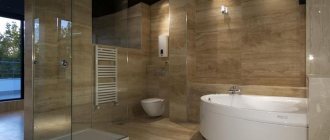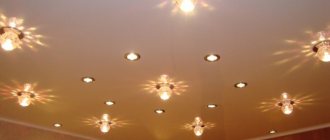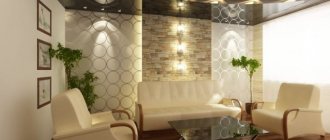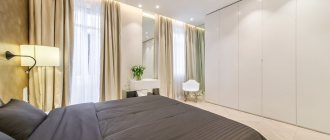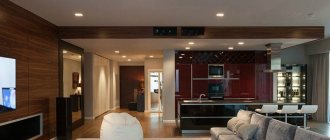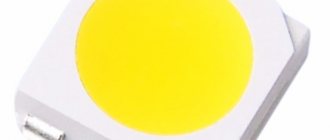This is especially true for those who, having a large family, cannot find a quiet and peaceful place for solitude for a long time.
To make your bathroom cozy and comfortable, you need to carefully consider the lighting and choose it in such a way that it is safe and harmonizes with the interior.
Remember that not all lamps that seem to fit perfectly into the design and suit you in all respects can be installed in the bathroom. Let's look at the main selection rules that you should focus on before running to the store to make a purchase.
Mistake 1. First beauty, then safety
When choosing light in the bathroom, use the principle of safety first, then everything else. No matter how beautiful the sconce is, it is not suitable for the bathroom if its protection index against moisture and dust is 0.
IP index on the packaging, photo example
Index of protection of the lamp against dust and water
The IP index consists of two numbers - IP 44. The first number (from 0 to 6) is the degree of protection against the ingress of solid particles (dust), the second (from 0 to ― protection from the ingress of liquid. The higher the number, the higher the protection. See the value on the packaging, lamp body or in the product characteristics in the online store.
The more IP a bathroom fixture has, the better.
Decoding the IP index for luminaires on the diagrams
Bathroom luminaire placement area based on IP
The choice of IP index for a lamp depends on where you install it - that is, on the location area.
- zone 0 - moisture enters directly by stream (bottom of the shower stall, bath screen, etc.);
- zone 1 - moisture often splashes (the wall of the shower stall, walls near the sides of the bathtub, etc.);
- zone 2 - moisture splashes infrequently (60 cm from the sides of the bathroom, behind the shower doors, etc.);
- zone 3 - moisture enters very rarely or never (near the ceiling, etc.).
From here it becomes clear that the sconce near the mirror should have a min IP index of 44, and the built-in lamp in the bottom of the shower should have a min IP index of 67.
Safe and unsafe zone for placing a lamp in the bathroom, taking into account the IP diagram
Bathroom lighting requirements
Correctly selected lamps should provide:
- safe operation without the risk of short circuit and electric shock;
- a sufficient level of illumination, both for the entire room as a whole and for its individual zones;
- compliance with the design style and overall interior.
The most important factor in choosing which light fixture is suitable for the bathroom is ensuring the safety of people. The bathroom belongs to the category of rooms with high humidity. Therefore, installation of lamps is allowed at a distance of at least 0.5 meters from any water source. In this case, the lighting device must have a sealed, moisture-proof housing, and the cables must be laid in a hidden way.
Attention! In areas of high humidity, lamps operating on 12 Volts should be installed.
The protection class of electrical equipment is determined according to the international IP index system. The higher the index, the safer the luminaire design. So IP44 means that the housing is protected from accidental splashes and isolated drops.
IP55 marking is a completely sealed product that can ensure safety even with a continuous directed jet. Maximum level of protection IP68 – the ability to be completely immersed in water.
All metal structural elements must be protected against corrosion or made of stainless materials.
Experts determine the optimal level of lighting for a bathroom at a level of 200 Lux, which can be provided by the power of electric lamps depending on the degree of shading, type and design of the lamp.
Mistake 2. Not taking into account the furniture arrangement plan and bathroom interior
It doesn’t matter whether you select lighting in the bathroom at the renovation stage (which is best) or in a finished apartment - do it taking into account the arrangement of furniture, total area, layout and color combinations. So, it is immediately clear how much working light is needed, whether there is a risk of dark corners, etc. For example, in a light bathroom with glossy tiles and an area of 8 m2, 4-5 ceiling built-in lamps (main lighting) and two sconces on the right and to the left of the mirror (working lighting). And in a bathroom with dark tiles, an area of 4 m2 and a sink in the corner, you will need more task lighting precisely because of the non-standard layout.
Non-standard bathroom layout with a sloping wall, photo example
Standard small bathroom layout
Before buying bathroom fixtures, think about the following:
- non-standard shape and area of the bathtub;
- interior color, whether there are reflective surfaces or more matte ones;
- and how much work light, main light or decorative lighting is needed;
- personal needs (are there elderly people in the house, a mirror in the bathroom instead of a dressing table, etc.).
Light-emitting diode (LED) lamps are slowly but surely replacing incandescent lamps, as well as fluorescent lamps. The growing popularity of LEDs is associated with low energy consumption, high luminous efficiency, and long actual shelf life. The high-tech nature of this type of lamp plays a role. Some modern models of autonomous LED sources can operate on solar batteries, without using an electrical network. This entire set of advantages allows us to predict the steady popularity of LEDs as lighting devices for the coming decades. It is not surprising that the installation of such devices in housing has ceased to be limited to living rooms and has moved to non-residential rooms: kitchen, corridor, bathroom, in particular, the bathroom. It is the latter type of premises that has its own special requirements for lighting devices, due to the presence of splashes and high humidity.
Criteria for choosing lighting fixtures for installation in the bathroom The main aspects that should be paid attention to when installing bathroom lighting with LED lamps are the following: brightness; moisture resistance; location; installation type. In addition, there are a number of criteria in the question of how to choose LED lamps for the bathroom, some of them relate to individual preferences based on color, shape and overall lighting design. The saving factor is also important. Each lamp is characterized by an energy saving class, which is indicated on the packaging. Almost all LEDs have an “A” rating on the energy efficiency scale. Improvements in technology are constantly reducing energy costs, so the latest LED models may belong to more efficient classes: “A+” or “A++”. Products with the lowest cost are preferable. Quality of room illumination: what to look for There are clear requirements for lighting brightness for various types of rooms
European standards are based on the current ISO 8995 standard, which provides for a bathroom illumination standard of 200 lux. This corresponds to a light flux of 200 lumens per square meter. An LED lamp with a power consumption of 2–3 W has approximately this degree of illumination. This makes it easy to calculate the total number of lamps: one 2-watt lamp per square meter.
If you plan to install a single light source, then to select an LED that provides comfortable lighting, you should take into account the fact that approximately 1 W of the power consumption of the LED source corresponds to a flux of 100 lumens. We multiply the number of square meters of the bathroom by 2 and get the required power of the LED lamp. If the bathroom is large, you can add 2 W on top for reserve. However, most modern packaging indicates the luminous flux in lumens. In this case, everything is extremely simple; when choosing, you need to adhere to the ratio of 200 lumens per square area.
Color Temperature The next thing you need to take into account when planning LED bathroom lighting is the different spectral composition of this type of lamp, or a more familiar definition - color temperature. It is measured in Kelvin (K) and classified into four ranges: cold, above 6000 K; white light, 4700 – 6000 K; neutral, 3500 – 4700 K; warm, 2000 – 3500 K. In this case, the choice is determined by the individual perception of the person. It is believed that the warm range of radiation is most suitable for the bathroom, as it is most pleasant to the eye. If you want to create a feeling of shine and sterile cleanliness, you can use a neutral color tone of light. Cold light in residential areas is highly discouraged, as it has a negative effect on the nervous system. Color rendering Another lighting parameter is the color rendering index, which indicates how natural colors objects appear under a certain type of lighting. For LED lamps, this characteristic ranges from 80 to 89. Natural color reproduction corresponds to a value of 100. The color rendering index, as well as the color temperature, must be indicated on the packaging. Directionality of radiation The radiation of LED lamps is directional and is characterized by the angle of light dispersion. The larger this parameter, the more evenly the area of the room will be illuminated. To create the effect of “spot bunnies,” on the contrary, lamps characterized by small angles are suitable. Multidirectional lighting in the bathroom Multidirectional lighting in the bathroom Ripple A possible disadvantage of LED lamps is the presence of pulsation, which occurs at high frequencies and is therefore invisible to human visual perception. Regular use of such a light source leads to fatigue and negatively affects the nervous system. High-quality LEDs do not have this drawback. The camera will help determine the presence of pulsation. Even the one installed on a mobile device is enough: phone, tablet, just point it at the turned on LED lamp. If the image blinks, this is a sign of the presence of pulsating light, it is better not to buy such a product. In addition, the manufacturer’s brand can serve as a guarantee of high-quality radiation. As an example, you can focus on the brands Osram, Paulman, Bioledex, Philips, which have a good reputation and experience in producing LED products. Protection from moisture Installing lamps in the bathroom imposes additional requirements on them in terms of moisture resistance. This will help protect expensive lighting elements from premature failure, prevent electric shock, and avoid short circuits. Many luminaires include an IP rating on their packaging, which is a two-digit number. The first parameter, with values in the range 0 – 6, determines the overall safety and the degree of obstruction to the penetration of dust and foreign particles. The second number directly represents the level of moisture resistance of lighting devices. There are 9 levels in total, marked with numbers from 0 to 8: No protection. Prevents vertically directed drops from entering. Protection against drops falling in sector 150 to the vertical axis. Resistant to rain and spray. Full splash protection. Resistant to jet water. Protection against water flow. Waterproof products. Sealed waterproof. Recommended reading: Connecting a chandelier in an apartment to a double switch with your own hands Combined lighting in the bathroom Combined lighting in the bathroom You can determine what level of protection is needed in each specific case based on the location of the lamp. So, at a distance of meters from the water source, class 1 will be enough. Approaching a washbasin or bathtub up to half a meter requires models with a protection level of 2 - 4. A closer distance involves installing light sources with moisture resistance in the range of 4 - 7. For the ceiling above the bathtub, in close proximity to the shower, LED products with the maximum level of protection will be required from water. Also, sealed waterproofness is necessary when installing decorative lighting located along the bottom of a bathtub, jacuzzi or shower stall. Such lamps have a completely sealed housing, thanks to rubber seals. Sealing of the installation is achieved by using special gaskets on the base of the product when attaching it. Before installing lighting, it is necessary to draw up a plan for the location of lamps. LED sources allow a wide variety of shapes, power, and sizes. Therefore, before installing bathroom lighting using LEDs, you need to decide how many, what size and light intensity of lamps will be installed. To do this, a diagram of their location is drawn up to ensure sufficient and uniform illumination throughout the entire volume. For a small bathroom of 3 to 5 square meters, one LED lamp is sufficient. Using a more powerful lamp, you can get by with a single light source even over large areas. However, in this case, when choosing an LED lamp, make sure that its light scattering angle is at least 1500, preferably 1600.
It must be taken into account that the radiation from an LED lamp is directional and not scattered, due to its nature. For a large bathroom, one lamp will not be enough to provide uniform illumination, regardless of the magnitude of the luminous flux, as well as the scattering angle. Therefore, it is better to illuminate large bathrooms with a large number of lower power LED lamps. This will achieve even, balanced light.
The presence of a mirror is a reason to install additional lights, the purpose of which will provide complete comfort when shaving for men or putting on makeup for women. Additional lighting inside cabinets and other bathroom furniture would also be helpful. This will help you easily find the accessories you need, even if the bathroom uses dim or colored lighting. Many bathrooms are equipped with additional borders. In this case, it is allowed to place LED lamps on their walls to clearly illuminate the design features of the floor. All these nuances are taken into account in advance, a lighting plan is drawn up, according to which LED devices of the required power, size, shape and type of installation are selected. If desired, you can set several lighting modes in the bathroom. For example, the main one is bright, sufficient lighting with white light and the relaxing one is dim light, white or a certain color. For an alternative circuit, you can use lamps of a different size, color, power, or an excellent LED structure. Quite popular are LED strips that create various patterns on the ceiling above the bathtub and have a simple mounting method. Installation, cooling and shape of LED lamps The simplest type of installation of LED lighting sources is typical for strip lamps. They are easy to stick to any surface, regardless of its type. For suspended or plasterboard ceilings, it is recommended to use point light sources. They are built in using special spring fasteners - lugs. For the main ceiling, it is better to choose lamps in the shape of a ball, plate, or half a sphere. Fastening will be carried out using ceiling lamps. LED lamps differ not only in the type of base, which is important during installation, but also in the type of bulb. These parameters are indicated on the packaging. Thus, the standard form, similar to an incandescent lamp, is defined as A55. Among other shape options, the most popular are: a candle, marked C35, and a ball, corresponding to G45. The type of flask is indicated on the packaging: matte, transparent or mirrored with a leading symbol R in the marking, for example R39. When choosing an LED lamp, you need to select the size so that there is a gap between the bulb and the lampshade. Although LEDs generate much less heat than incandescent bulbs, insufficient clearance can lead to product failure. Naturally, you need to pay attention to the lamp base. Its marking must correspond to the type of cartridge connector. In addition, make sure that the base is securely fastened and there is no play. Low-quality products are still found among LED lamps. The markings of the base and cartridge must match. Products with high power consumption require a radiator to passively cool the crystals, preferably ceramic or made of graphite. A cast aluminum version is also suitable; a stacked radiator is not recommended. LED sources are very sensitive to the heating of crystals, this affects their service life. Moreover, at high temperatures, the radiation intensity of the LED crystals, and accordingly the brightness of the lamp, decreases. Directional lighting in the bathroom Directional lighting in the bathroom
Conclusion Although relatively new, LED lamps are increasingly being introduced into our everyday life. The process of choosing this type of lamp is simple, due to the presence of almost all the key information on the packaging. It remains to remember one old truth: quality and incredibly low prices are rarely compatible. Therefore, when going for LED lamps, start from brands that have a reputation in this market segment. Two cheap models are always more expensive than one high-quality one.
Mistake 3: Using only one light source
Usually the third error follows from the second. They installed a light in the bathroom, but didn’t think about the nuances.
Main and task lighting in the bathroom
Ceiling lighting (chandelier, lamps) provides general diffused light, which is convenient for taking a bath, but it is not suitable for shaving or applying makeup. Look at the picture below. Overhead light creates shadows on the face and highlights imperfections. Two wall lamps on the right and left or above the mirror will correct the situation (read about bathroom sconces here).
Main and task lighting in the bathroom, what is the difference?
General lighting is light that is evenly distributed over the entire area.
Working lighting - light near functional areas.
Power of bathroom fixtures: formula
The power of the lamps in the bathroom is the brightness of the illumination of the entire space. To correctly calculate the power, use the formula - type of light bulb (power consumption from the table below) * room area .
Formula for calculating the power of bathroom fixtures
*Lumen measures how much light you get from a light bulb. The more lumens, the brighter the light. The norm is 300 lumens per square. Read more about light bulbs in the following. point.
In practice it looks like this:
Bathroom area - 8m2
The power consumption of one incandescent lamp is 20 W.
8*20=160W - this is the amount of power needed to create comfortable lighting and 160 W - this is the total power for all lighting fixtures in the bathroom. That is, there are 4 of them, then 160/4 = 40 W - the power of each lighting device, if all of them have incandescent lamps.
Please note that results will vary for halogen, energy saving and LED bulbs. Use the formula we provided and you will quickly determine the necessary indicators.
IMPORTANT: The power calculation formula is suitable for bathrooms with ceiling heights below 3 meters. If the ceilings are higher, multiply the resulting power by 1.5. This is necessary because high ceilings “eat up” the light.
Example of dim lighting in a dark bathroom
An example of bright lighting in a bright bathroom
Comfortable lighting (light strength and temperature)
Before we move on to choosing specific places to install lighting, we need to understand what strength and temperature we need light in each specific zone. Clarity on these issues will make the lighting in each zone extremely comfortable and cozy.
For each zone, a balance must be struck between the intensity (measured in lumens or Lm) and the temperature of the light (measured in Kelvin or K).
| Type and power of lighting fixture | Number of lumens |
| Halogen lamp, 42 W | ~625 |
| Halogen lamp, 70 W | ~1170 |
| Fluorescent lamp, 40 W | ~1800 |
| LEDs, 40-80 W | ~6000 |
For a bathroom with an area of 8 m2, one 40-W fluorescent lamp is enough for you to see, but you definitely shouldn’t count on comfort with such lighting. If the room is decorated in light colors and has a lot of glossy surfaces and mirrors, then the lighting level can be left within 200 Lm per 1 m2 or even a little less. If the finish is dark, this figure can be increased slightly, for example, to 250 Lm.
| Lamp type | Advantages | Flaws |
| Halogen | Color rendition Compactness Low cost | Intolerant of flask contamination Not sold everywhere High heating temperature |
| Luminescent | Energy efficiency Prevalence Low cost | Blue-shifted emission spectrum Harmful to the environment Poor compatibility with LED switch (flashes when off) |
| LED | Energy efficiency Prevalence Durability Environmentally friendly Doesn't heat up | High price Sensitive to voltage changes |
It is worth mentioning the temperature of light, which is measured in Kelvin (K).
| Colorful temperature | Shade of light | Application |
| 2500-3000 3000-4000 | Warm white | To create a cozy evening atmosphere. Can be used in the bathroom area. |
| 4000-5000 | Neutral white | Regular daylight. Suitable for washing, changing and lighting areas in the shower. |
| 5000-6000 | Cold white | For shower cabin. |
We see the most rational use of warm shades of light in the bathroom area, because the bathroom is used not only for sanitary and hygienic purposes, but also for relaxation, therefore warm orange or yellowish light will create a more comfortable and calming atmosphere. In other areas, neutral white light will be sufficient. An LED strip is ideal - its use will provide the necessary level of illumination, and will also allow you to save space and not worry about heat generation.
Mistake 4. Not paying attention to the type of light bulbs in the lamp
There are several types of lamps: halogen, incandescent, fluorescent, LED, etc. It is the light bulbs in the lamp that determine how long they will work, how bright the lighting will be, etc.
| Lamp type/criteria | Incandescent* | Halogen** | Luminescent*** | LED**** |
| Safety | — | + | + | + |
| Electricity consumption | — | — | + | + |
| Price | from 42 rubles (+) | from 67 rubles (+) | from 350 rubles (-) | from 260 rubles (-) |
| Life time | up to 1000 hours (1.5 months) (-) | up to 2.5 thousand hours (3 months) (-) | up to 10 thousand hours (more than a year) (+) | more than 50 thousand hours (6 years) (+) |
| Brightness | — | + | + | + |
| Conclusion | + | ++ | +++ | ++++ |
* Incandescent lamps do not like humidity. Being very hot, it will burst if a few drops of water get on it. It flares up quickly, but produces a weak luminous flux. The incandescent lamp is the most power-hungry of all, but also the cheapest.
** Halogen lamps in terms of price/quality ratio are the most affordable and convenient option. They give a warm, diffused glow. They get hot, but not much. And they do not consume as much electricity as incandescent lamps.
*** The fluorescent lamp is completely safe in humid conditions. It produces a powerful luminous flux, but flares up in about 2 minutes, so it works better in combination with other types of lamps. It works silently.
**** LED lamps are the most economical of all. But due to voltage surges, they “clack”, creating unpleasant sounds. The downside is the high price.
A universal option for lighting in the bathroom is a combination of halogen and LED bulbs.
IMPORTANT : Halogen light bulbs for suspended ceilings must be covered with paint or a special coating on the reverse side. Thus, the platforms will not show through and create unsightly shadows in the stretch ceiling (see photo below).
Halogen light bulbs in the bathroom, photo example
LED light bulbs in the bathroom, photo example
TIP: Pay attention to the color of the halogen and LED lamps. Halogen ones give a warm light, while LED ones give a bright, white light.
Glow of halogen and LED light bulbs in the bathroom
Types of waterproof lamps
Waterproof equipment is usually divided into different types depending on the installation location, installation method and type of light bulbs. Each type of lamp has both pros and cons. Therefore, it is impossible to single out any type of lighting fixture as the best.
Lamp location
There are three types of devices - wall-mounted, ceiling-mounted and floor-mounted. Usually they try to install the first two, much less often they are placed on the floor. The main reason for this is that bathrooms are rarely large enough to accommodate a floor lamp. It is the lack of space that dictates the need to install all kinds of interior details in niches, suspended ceilings, under the sink or bathtub.
Mounting method
According to this feature, lamps are divided into three types:
- Built-in (mortise). Installed on the ceiling, in walls or floors, in furniture or any other interior items. They are characterized by a significant variety of dimensions and shapes. At the same time, they are the simplest in design: they are a housing equipped with clamps.
- Overlays (external). Such devices are placed on solid foundations. External models are popular in cases where it is impossible to install a mounting niche (for example, when it comes to a concrete ceiling). Also, overhead devices are used if the lighting device is used not only for its intended purpose, but also as decoration. There are many variations in execution: from the most unremarkable to the most exquisite. Based on their location, overhead devices are divided into ceiling-mounted and wall-mounted.
- Hanging. This type of lamps is the least used. Such devices are suspended from a ceiling mount. In this case, the device is not located flush with the ceiling, but at a certain distance. For fixation, hooks, hangers, or even a power cable are used. Any ceiling is suitable, including slatted, suspended ceiling, concrete, and plasterboard. The main condition is that the ceiling height must be sufficient for mounting the lamp. Suspended models are also available for wall mounting and are mounted on adjustable brackets.
Bulb type
The brightness of the light and energy consumption depend on the type of lamp installed in the lamp. Most lamps are suitable for any type of light bulb, so the choice of a specific type depends on the preferences of the residents.
| Type of light bulb | Technical features |
| Luminescent | Characterized by low power consumption and long service life. The light spectrum practically corresponds to daylight. Light output is higher compared to incandescent light bulbs. The disadvantages of fluorescent light sources are damage due to voltage surges, high prices for lamps and a delay in warming up |
| Incandescent lamps | This type is resistant to temperature changes and power surges. There are light bulbs on sale with a matte coating, the light from which spreads more evenly and does not give a glare effect. For the bathroom, you should choose lamps in the power range from 15 to 40 W. The disadvantage of this type of device: the light bulbs are prone to severe overheating, which leads to the melting of the housing made of plastic |
| Halogen | This type of lamp produces a directional beam of light and is typically used for recessed lighting. Halogen light bulbs are characterized by increased luminous efficiency, long service life, and compactness. Disadvantages of halogen lamps: rapid overheating, responsiveness to power surges, sensitivity to the appearance of grease stains on the surface. The last disadvantage entails the need to use gloves or wipes when handling these light sources |
| LED | Diode bulbs operate from a low-voltage power supply and are therefore absolutely safe. LEDs do not overheat, use energy sparingly, and provide good light output. Their service life is longer compared to any other types of light sources. They have LEDs and a significant drawback - high cost |
Mistake 5. Choosing bathroom fixtures without taking into account the height and type of ceiling
Recessed ceiling lights for small bathrooms
Such lamps are distinguished by the fact that almost their entire body is located under a suspended or suspended ceiling. Only a decorative trim peeks out from the outside. They look minimalistic and do not press on top, so they are suitable for small bathrooms with low ceilings.
Recessed ceiling lights for small bathrooms
Recessed ceiling lights in the bathroom interior
Surface-mounted lights for medium-sized bathrooms
The overhead model is not built into the ceiling, so it takes up more height than built-in models. But despite this, there are also compact overhead lamps that will fit a standard ceiling and will not take up much space.
Surface-mounted lights for medium-sized bathrooms
Overhead lamps in the bathroom interior
Wall lights for functional areas
For example, wall spotlights above a mirror create accent task lighting. Here, too, it is better to adhere to the principle: small bath - compact lamps, and vice versa.
Wall lamp above the mirror in the bathroom
Wall sconces to the right and left of the mirror in the bathroom
The best manufacturers
The most popular products from the following companies:
- Downlight Lug. The Polish company primarily produces lamps for bathrooms. Waterproof and impact-resistant products are equipped with specially shaped housings and lampshades, thereby preventing excessive light scattering. The devices allow you to redirect the light flux in the desired direction, which is convenient for zoning the room. There are several lines of this Polish manufacturer, including Vandallug, Diamond and Star Premium lamps.
- Massive (Belgium). The products of the Belgian manufacturer belong to the upper price category and are of high quality. Lamps of various protection classes are produced. Some products are designed to work in saunas or baths, and not just bathrooms. The range includes both ceiling and wall lamps. The company has several product lines that differ in style: Aqua Oasis, Katie and Adrio.
- Eglo (Austria). The products are characterized by a unique design: the lamps are made in curved shapes with soft outlines. Lampshades are usually plated with chromium or nickel, since these metals protect the base material from oxidation. Some products are made of plastic and covered with fiberglass for greater durability. The company's product range includes wall and ceiling lamps. Among the brands worth noting are Palmera and Mono.
- Arte Lamp (Italy). The products of the Italian company are distinguished by high quality, bold design and long service life. Product lines: Hall, Aqua.
- Kanlux (Poland). The company produces both built-in and hanging lamps (ceiling and wall). The scattering elements are made of metal with polymer inserts. The fasteners are made of stainless steel. Pendant light housings are usually polyester or fiberglass. Of all the listed manufacturers, Kanlux produces the most affordable products. The most popular brands are Volin, Argus (with switch), Turk.
Mistake 7. Buy a chandelier/sconce with a dark shade and pattern
The material of the lampshade or floral shades can eat up the light power and convey the color of the light incorrectly. For example, a lampshade made of dark, light-retaining material reduces the level of illumination, which is most inconvenient in the bathroom, while many decorative details leave a shadow. Therefore, check immediately in the store how overly designer and decorative models transmit light.
Unsuccessful sconce for the bathroom, photo example
A successful example of a sconce for a bathroom, photo example
Where to install?
Waterproof bathroom fixtures can be installed;
- on the ceiling;
- on the wall;
- on the floor.
Each of these options has its own unique features. Bathroom ceiling lights
Mistake 8. Not paying attention to the material of the lamp
Even the most fashionable metal sconce without a protective layer will eventually become covered with red spots. And models made of glass and plastic will last much longer. Such materials are not destroyed by moisture and detergents, and in the long run save time and money. If you still cannot do without metal materials, check the composition for the presence of a reliable powder coating (protective layer).
Unsuitable material for bathroom fixtures
Suitable material for bathroom fixtures
Influence of layout and design on lighting choice
Now let's move on to specific locations for installing light sources and their types and how all this relates to aesthetics.
The choice of bathroom fixtures will be influenced by the following factors:
- room dimensions and ceiling height;
- number and location of functional areas (combined bathroom or bathroom, but containing not only a bathtub and sink, but also a shower stall or home sauna, hydrobox);
- the presence of a natural source of light (in private homes, a bathroom with a window is not uncommon);
- the number of mirror surfaces also affects the choice of lighting power;
- color palette of the interior (for light, snow-white surfaces that perfectly reflect light, you will need lamps of lower power than for decorating a bathroom in dark colors).
The power of lighting devices can be selected and adjusted (the device can be equipped with a remote control, or a regular lamp can be equipped with a dimmer instead of a switch).
If you choose lamps with decorative hanging elements, then it is necessary to take into account the play of light and shadow from such decorations on the surfaces of the room (the most unsuitable device from this point of view is one with a stained glass shade). You should definitely not install lights of different colors in the wash area - they will inevitably distort your reflection in the mirror. In spacious bathrooms, light elements grouped in several pairs, forming a single figure, will look more harmonious than single lamps.
The design of lighting devices should be harmonious. It is important to consider a number of rules:
- If the bath area is large enough, it is better to use a central lighting source with several lamps that provide uniform diffuse lighting. But a hanging chandelier with low walls will make your bathroom uncomfortable, in which case it is better to use spotlights or spotlights;
- When choosing a lighting fixture design, be guided by the interior style of the room. If the room is decorated in a modern style, for example, hi-tech or minimalism, then metal lamps of simple and strict shapes will look great. If the interior is classic, give preference to chandeliers and sconces;
- If the room is decorated brightly, then the lamps should also be noticeable so that they serve as an accent and decoration of the room even in daylight. If the interior contains a minimum of decorative elements, it is better to use inconspicuous lighting devices, for example, built-in ones;
- Eco-style or country style can be effectively emphasized by lamps made in the form of street lamps.
Mistake 9. Confusing decorative and main lighting
A sconce with a colored lampshade and an LED strip on a plasterboard ceiling will not replace the main lighting. The light from a colored sconce near the mirror will distort the reflection, and the LED strip will only create a relaxing atmosphere. Therefore, divide all lighting into three groups: basic (chandelier, ceiling lamps) to wash the floor, task (wall lamps near the mirror) to apply makeup and decorative (LED strip on the steps or ceiling) to leisurely take a bath.
Decorative lighting in the bathroom
Decorative lighting in the bathroom
Basic lighting in the bathroom
Main lighting in a spacious bathroom
Useful tips
- Almost all types of lamps are suitable for plasterboard ceilings. For tensioning, it is better to choose overhead options. Plafonds-plates are not used for it.
- The power of halogen lamps in the bathroom should not exceed 35 W.
- Energy-saving minions will also come in handy - they will dim the lights and save money.
- Lamps opposite the mirrors provide almost twice as much light.
- Pendant lights are suitable for spacious bathrooms. Spot - for small rooms.
- LED strips in matching colors look beautiful under the sides of the bathroom, window sills and shelves.
- Don't forget about lighting inside the cabinets. This is a small thing, but important: it determines convenience.
- It is forbidden to install sconces above the bathtub for safety reasons.
- It would be great if there was one switch for all lighting fixtures at the exit from the bathroom.
So, before buying lighting fixtures for the bathroom, you must decide on the zoning of the bathroom, protection classes of lamps, light parameters (power and temperature), adapt the general lighting scheme to your bathroom, choose specific models of lamps within your design and at the same time fit into the family budget .
The entire range of bathroom fixtures is presented in our catalog HERE
In our store ELECTRICAL-HERE
There is a wide selection of bathroom fixtures of various models.
So any housewife can choose an option to her liking. Our address: Ivanovo, st. Kalinina, 10
Bathroom lamp layouts: real examples
Lamps in a dark bathroom with an area of 4 m2 and ceilings of 2.9 m
Project by designer Yulia Chernova
General lighting : 4 built-in spotlights - 2 above the sink, 1 above the bath, 1 above the toilet.
Working lighting : LED lighting around the perimeter of the mirror.
Layout of four lamps in the bathroom, real photo example
Lamps in a bright bathroom with an area of 6.5 m2 and ceilings of 2.9 m
Project "Côte d'Azur", CO:interior
General lighting: 6 spot built-in ceiling lights - 2 of them are accent lighting above the bathtub, 2 above the shelf in the niche, 2 on the sides of the bathroom so that there are no dark corners.
Working Light:
2 accent sconces above the mirror, 2 spotlights on top in the shower stall.
Layout of ten lamps in the bathroom, real example
Layout of ten lamps in the bathroom, real photo example 2
Types of electric lamps
The quality and comfort of bathroom lighting largely depends on the design and technical characteristics of the installed electric lamps, which can be:
- with filament coil;
- halogen;
- LED;
- luminescent.
They differ in design, energy consumption level, service life, cost and other indicators. The individual characteristics of the light source directly determine the illumination in the room and the level of energy consumption.
Incandescent lamps. Perhaps the only advantage of incandescent lamps is their low cost. In all other respects, they are inferior to new modern models. These are high energy consumption, short service life, not always convenient shape and large overall dimensions, frequency flicker and lack of protection against power surges in the network.
Manufacturers produce matte lamps that distribute the light flux more evenly. They soften harsh light and make it more pleasing to the eye.
Halogen light sources. These lamps have the highest luminous efficiency, creating a powerful directional stream of light. Therefore, they are most often installed in built-in spotlights and spots. The service life of halogen lamps is 2-3 times longer than that of incandescent lamps.
The disadvantages are considered to be rather strong heating during operation, increased energy consumption, and sensitivity to voltage changes in the network.
Luminescent. The light output of fluorescent sources is 5-6 times higher than that of incandescent lamps of the same power. As a result, they consume much less electricity and have a long service life. The light emitted is very close to the natural solar spectrum.
The disadvantage is the long warm-up time to working condition and the high cost.
LED. The operating voltage of the LEDs is 12 or 24 volts. Moreover, a device for reducing voltage is included in the design of the lamp. Therefore, they are recognized as the safest light sources for rooms with high humidity. LEDs consume minimal energy, do not heat up and have high light output. A good LED spotlight for the bathroom can last up to 100 thousand hours.
Selection of ceiling lights
Light sources for a regular ceiling.
The most acceptable option for such a ceiling would be a ceiling lamp with energy-saving, conventional or halogen lamps. Built-in and point-mounted devices for the base ceiling will not fit the design.
- Lampshades, as a rule, consist of a reflector disk made of metal, a socket and a light diffuser that can protect the lamps from splashes.
- The lampshades are aesthetic, durable and quite safe.
- They have a wide variety of options at low prices.
- The only drawback is that when replacing the lamp you will have to remove the diffuser each time.
Lamps for plasterboard ceilings.
- When using halogen lamps, the plasterboard structure should be at a distance of three to six centimeters from the ceiling.
- For spotlights with incandescent lamps protected by a casing, up to twelve centimeters from the ceiling height will be required.
- For plasterboard structures, lampshades can also be used. But they shouldn't be heavy.
Light sources for suspended ceilings.
When choosing lamps for such a ceiling, you should know that halogen lamps should have a power of no more than thirty-five watts, and incandescent lamps should have a power of up to sixty watts.
- When installing devices, you must correctly determine the distance to the canvas, which may be damaged in the event of strong heating.
- Preference should be given to spotlights with a thermal ring, which are equipped with diode, energy-saving and halogen lamps.
- Ceiling lamps with energy-saving lamps would also be a good option. They are mounted on the base ceiling, practically do not heat up and save energy.
- A diode strip will look impressive on a stretch ceiling. With its help you can create a soft glow or focus on any element.
Power level
According to international standards, for every square meter of a bathroom there should be 200 lux of light. Multiply the area of your bathroom by this figure.
The resulting value must be divided by the number of lamps, taking into account what type of lamps will power them. For example, an energy-efficient fluorescent lamp can provide up to 7 times more light than a traditional incandescent lamp.
Design features of lamps
Directional light is a great opportunity to experiment with lighting work areas, which is why rotating lamps are often used as artificial light sources. They have a simple design: the base is fixed, and the outer part is dynamic, that is, it rotates in opposite directions or in a circle.
For surface-mounted lamps, the angle of rotation allows you to direct the beams to any selected area - on the washbasin, bathtub, dressing table, cabinet. Rotating products are good for highlighting interesting, exclusive details of the bathroom interior, acting as decor: an unusual vase, a beautiful panel on the wall, an elegant floral composition.
One of the options for a rotary-type built-in spotlight: the moving part with the lamp allows you to adjust the flow of light in opposite directions with a “run-up” of 180º
Fixed models have rigid mounts; the light from them falls in one constant direction, most often downward. To effectively distribute the luminous flux, lamps are mounted in groups, which can be located in different ways: around a circle, in a line, around the perimeter.
As a rule, work areas require a lot of light, so non-rotating products are installed above a mirror, washbasin, bathtub or dressing area. The larger the room, the more lamps will be needed.
Traditional arrangement of fixed spotlights around the perimeter of the bathroom: the light from the light sources is evenly distributed over the area of the entire room
The level of light in your bathroom
It is advisable that the switches are located conveniently; try to install sockets with closing surfaces - water should not get inside such devices. Use closed cabinets and curtains in your bathroom; the humidity in such a room is high; lighting fixtures should provide maximum light so that the farthest corners of the room are visible. It is believed that the bathroom is one of the most problematic in the house, so try to protect yourself as much as possible. The lighting in the room should be done with only warm shades. Cold light will give you the unpleasant appearance of a “living corpse.”
An LED strip near the mirror and several wall-mounted lighting fixtures, if the area of the room allows them to be installed, are ideal for the usual sealed ceiling lamps.
Lamp power and luminous flux
To avoid straining your eyes trying to see small inscriptions on toothpaste, washing powder or clothing labels, the bathroom must be illuminated with at least 50 lux. It is this illumination that is prescribed by current sanitary standards and rules. An illumination of 50 lux approximately corresponds to the illumination of every 1 square meter:
- incandescent lamp with a power of 25-30W;
- energy-saving lamp with a power of 5-7W;
- LED lamp with a power of 3-4W.
That is, if you have a small bathroom, for example 3x3 meters, for good lighting you will need to place in it:
- Incandescent lamps with a power of 3x3x30 = 270W.
- Energy-saving lamps with a total power of 3x3x7 = 63W (for example, 6 lamps of 11W each).
- LED lamps with a total power of 3x3x4 = 36W (for example, 4 lamps of 9W each).
As you can see, using LED lamps will help you save a lot of money on your electricity bills. Considering the service life and how these types of lamps have become cheaper today, they can be considered the best choice.
We've sorted out the power. How to choose lamps based on moisture resistance? Read more about this.
Ideas in various interior styles
In the classic style, the furnishings are decorated with steel or forged bronze candelabra and crystal products with numerous pendants, chains, beads and other decorative elements are used.
For minimalism, it is appropriate to use pendant lamps that have a simple shape and lack of decor. In the interior there are often models with round shades in the form of balls, cones or abstract lamps.
Provence is characterized by floor lamps, volumetric chandeliers and metal or wooden candelabra. To complement the beautiful interior composition, massive forged chandeliers with glass lampshades are selected and lamps or sconces in the shape of inflorescences are placed near the mirror.
The photo shows a lighting option for a bathroom decorated in a modern style.
LED lighting in combination with metal halogen lamps fits perfectly into the loft style. To enhance the industrial atmosphere, use pendant lamps on thick chains or cords that resemble wires.
Scandinavian interiors include any type of wall or ceiling lamps that can be combined with modern LED lamps. This style does not accept overly bulky and pretentious light sources.
